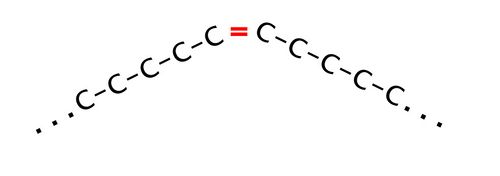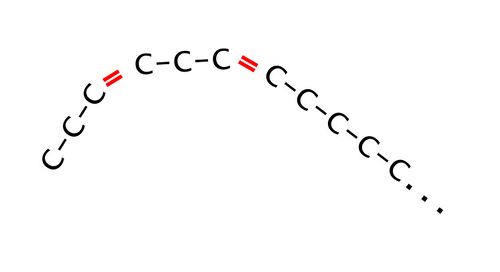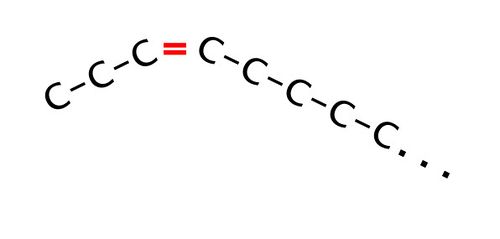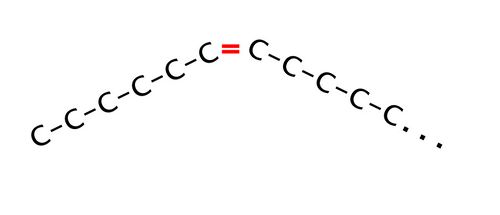Omega 3
Omega 3 is a type of fat that the human body cannot produce on its own, which is why it is called 'essential'. To understand what an Omega 3 is, we need to go over a little bit of chemistry. Fats are made from a long chain of carbon atoms, like this:
These carbon atoms can be joined together with a single bond or a double bond. The double bonds are important, because they cause a bend in the chain, whereas the single bonds are straight.
That means that the mix of single and double bonds creates different shaped fats and our bodies make use of these different shapes to do different things, like make hormones. If there are no double bonds, then this is called a saturated fat, a single double bond is a mono unsaturated fat, and two or more double bonds are poly unsaturated fats.
The name 'omega 3' comes from the fact that the bond between the 3rd and 4th carbon atoms is a double bond.
An Omega 6 oil has a double bond between the 6th and 7th carbon atom.
Omega 6 oils are also essential, but they are also quite plentiful and we tend to get too much Omega 6 and not enough Omega 3.
- It's believed that we should get a 1:1 ratio of Omega 3 to Omega 6, but most people get far too much Omega 6, and very little Omega 3. (Typical Western diets provide ratios of between 10:1 and 30:1.)
- If you feed cows (and other grazing animals) on grass, they have a 1:1 ratio of Omega 3 to Omega 6 in their milk and meat. However, if you feed them on corn, they have very little Omega 3, which is bad for the cow and bad for us too.
- A lack of Omega 3 and a bad Omega 3 to Omega 6 ratio has been linked to health problems, including cardiovascular disease.
- Omega 3 has anti-inflammatory properties, whereas Omega 6 is pro-inflammatory.
- The length of the carbon chain is also significant. Omega 3 oils from plants have shorter chains lengths than from fish or animals.
- Flax seeds are one of the few plant sources that is much higher in Omega 3 than Omega 6.
- Two especially valuable Omega 3 oils are EPA, DHA. These are plentiful in oils from cold water fish such as cod liver oil or from sardines. Free range chickens and chickens fed extra flax seeds cause their eggs to contain more DHA.
- It is believed that only about 5% of the shorter, plant based Omega 3 oils can be converted to the longer chain variants we need.
- A fat and an oil are the same thing, but fats are solid at room temperature while oils are liquid. Typically a fat is saturated and an oil is unsaturated as the double bonds change the melting point.
- While there are some concerns that Omega-3 might raise blood sugar levels, this is probably only true for type-2 diabetics that take high doses (>8g/day).
- A review of studies in the late 1980s/early 1990s showed that high levels of omega-3 supplementation in type-2 diabetics raises fasting glucose[1].
- Type-2 diabetics had higher fasting glucose levels after taking 18g/day of fish oil for a month[2].
- Giving type-2 diabetics 8g/day of fish oil impaired the effect of a blood glucose lowering medication (glyburide )[3].
- Type-2 diabetics given 8g/day of fish oil had higher fasting glucose levels and increased post-prandial glucose[4].
- A study giving 10g/day of fish oil or safflower oil adversely affected glycemic control in type-2 diabetics, but this may be due to the increased calorie intake (900 Calories/day)[5].
- However, it is believed that these increases were due to the high levels of supplementation[6].
- Obese patients with impaired glucose tolerance (IGT) had no change in fasting blood glucose levels, nor a change in glucose response when given 30ml of fish oil for two weeks[7].
- A meta-analysis of 18 trials covering 823 patients concluded that fish oil had no statistically significant effect on fasting glucose of type-2 diabetics[8].
- Overweight hypertensive patients given 3.65g fish oil daily for 16 weeks had no change in glucose or insulin response , though the combination of fish oil and weight loss improved glucose and insulin response more than weight loss alone[9].
- A review of studies in the late 1980s/early 1990s showed that high levels of omega-3 supplementation in type-2 diabetics raises fasting glucose[1].
- The 2003 American Heart Association statement concluded that "Omega-3 fatty acids have been shown in epidemiological and clinical trials to reduce the incidence of Cardiovascular disease", though they noted that the recommended intake is unclear[10].
1 References
- ↑ Joyce A. Nettleton, Omega-three Fatty Acids and Health, date 31 December 1995, publisher Springer, isbn 978-0-412-98861-5
- ↑ H. Glauber, P. Wallace, K. Griver, G. Brechtel, Adverse metabolic effect of omega-3 fatty acids in non-insulin-dependent diabetes mellitus., Ann Intern Med, volume 108, issue 5, pages 663-8, May 1988, PMID 3282462
- ↑ S. Zambon, KE. Friday, MT. Childs, WY. Fujimoto, EL. Bierman, JW. Ensinck, Effect of glyburide and omega 3 fatty acid dietary supplements on glucose and lipid metabolism in patients with non-insulin-dependent diabetes mellitus., Am J Clin Nutr, volume 56, issue 2, pages 447-54, Aug 1992, PMID 1636624
- ↑ K. E. Friday, M. T. Childs, C. H. Tsunehara, W. Y. Fujimoto, E. L. Bierman, J. W. Ensinck, Elevated plasma glucose and lowered triglyceride levels from omega-3 fatty acid supplementation in type II diabetes, Diabetes Care, volume 12, issue 4, 1989, pages 276–281, ISSN 0149-5992, doi 10.2337/diacare.12.4.276
- ↑ M. Borkman, D. J. Chisholm, S. M. Furler, L. H. Storlien, E. W. Kraegen, L. A. Simons, C. N. Chesterman, Effects of Fish Oil Supplementation on Glucose and Lipid Metabolism in NIDDM, Diabetes, volume 38, issue 10, 1989, pages 1314–1319, ISSN 0012-1797, doi 10.2337/diab.38.10.1314
- ↑ J Nettleton, R Katz, n-3 long-chain polyunsaturated fatty acids in type 2 diabetes: A review, Journal of the American Dietetic Association, volume 105, issue 3, 2005, pages 428–440, ISSN 00028223, doi 10.1016/j.jada.2004.11.029
- ↑ P. Fasching, K. Ratheiser, W. Waldhausl, M. Rohac, W. Osterrode, P. Nowotny, H. Vierhapper, Metabolic Effects of Fish-Oil Supplementation in Patients With Impaired Glucose Tolerance, Diabetes, volume 40, issue 5, 1991, pages 583–589, ISSN 0012-1797, doi 10.2337/diab.40.5.583
- ↑ V. M. Montori, A. Farmer, P. C. Wollan, S. F. Dinneen, Fish oil supplementation in type 2 diabetes: a quantitative systematic review, Diabetes Care, volume 23, issue 9, 2000, pages 1407–1415, ISSN 0149-5992, doi 10.2337/diacare.23.9.1407
- ↑ TA. Mori, DQ. Bao, V. Burke, IB. Puddey, GF. Watts, LJ. Beilin, Dietary fish as a major component of a weight-loss diet: effect on serum lipids, glucose, and insulin metabolism in overweight hypertensive subjects., Am J Clin Nutr, volume 70, issue 5, pages 817-25, Nov 1999, PMID 10539741
- ↑ P. M. Kris-Etherton, Fish Consumption, Fish Oil, Omega-3 Fatty Acids, and Cardiovascular Disease, Arteriosclerosis, Thrombosis, and Vascular Biology, volume 23, issue 2, 2003, pages 20e–30, ISSN 10795642, doi 10.1161/01.ATV.0000038493.65177.94




